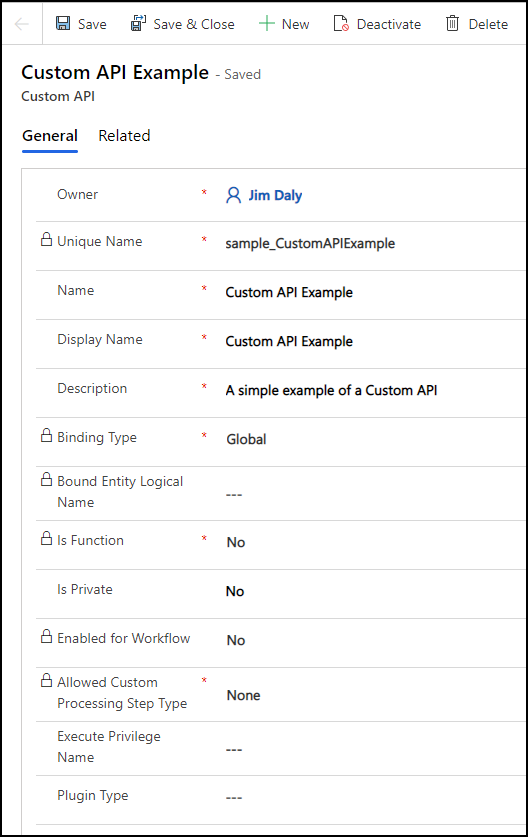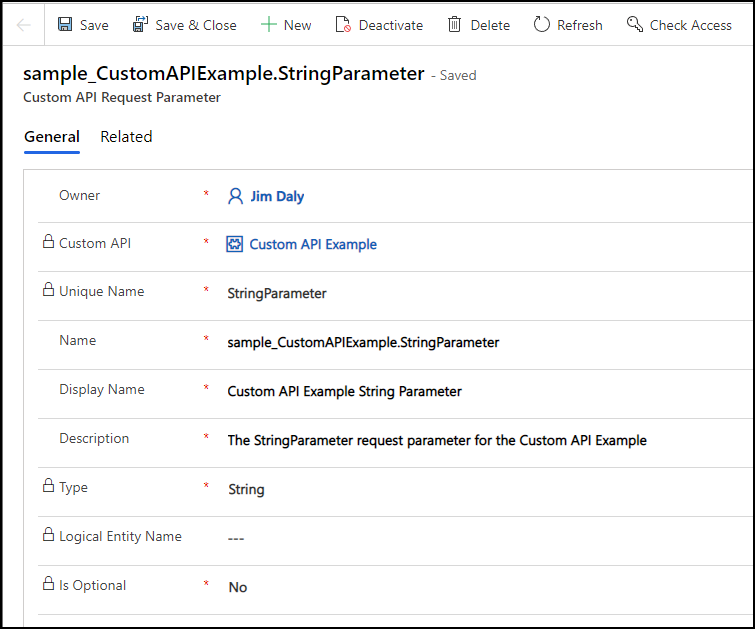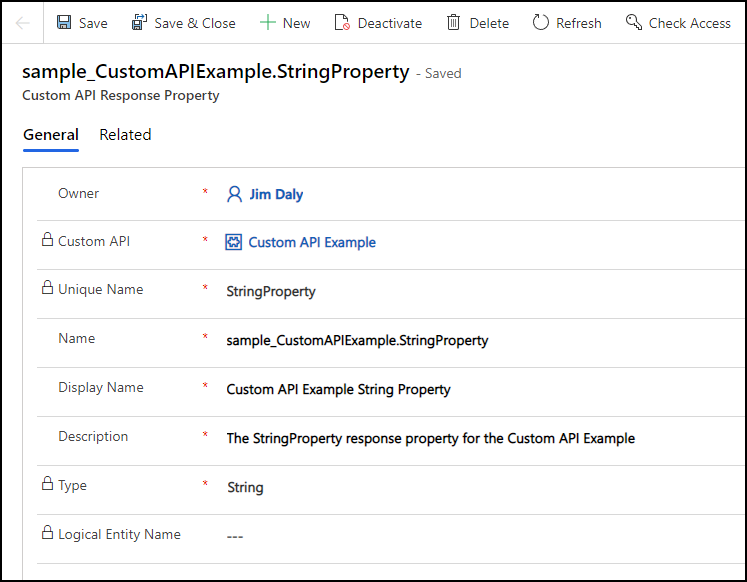Not
Bu sayfaya erişim yetkilendirme gerektiriyor. Oturum açmayı veya dizinleri değiştirmeyi deneyebilirsiniz.
Bu sayfaya erişim yetkilendirme gerektiriyor. Dizinleri değiştirmeyi deneyebilirsiniz.
Özel API oluştururken bir çözüm kullanmanız gerekir. Çözümler hakkında bilginiz yoksa, önce Çözüm oluşturma'yı okuyun.
Çözümünüz bir yayımcıyla ilişkilendirilmelidir. Yayımcının kendisiyle ilişkilendirilmiş belirli bir özelleştirme ön eki vardır. Özel API oluştururken özelleştirme ön eki kullanmanız gerekir ve bu ön ek çözümünüzün yayımcısı tarafından kullanılanla aynı olmalıdır. Yayımcı için ayarlanan özelleştirme ön eki olarak sample değeri aşağıdaki yönergelerde kullanılır.
Önemli
- Artık özel API oluşturmak için daha iyi bir deneyim var. Eklenti kayıt aracında bir tasarımcı kullanabilirsiniz. Daha fazla bilgi: Eklenti kayıt aracını kullanarak özel API oluşturma
- Özel API oluşturmayla ilgili birçok alan oluşturulduktan sonra değiştirilemez. Başlamadan önce özel API'nin tasarımını dikkatlice planlamanız gerekir. Daha sonra özel API'yi oluşturduktan sonra bazı şeyleri değiştirmeniz gerektiğine karar verirseniz, mevcut kaydı silmeniz ve özel API'yi yeniden oluşturmanız gerekebilir. Değiştirilemedik sütunlar hakkındaki bilgileri burada gözden geçirin: ÖzelAPI tabloları
Özel API kaydı oluşturma
Çözümünüzde açılan listeden Yeni>Diğer>Özel>API'yi seçin.
Özel API'nizin özelliklerini ayarlamak için alanları düzenleyin. Aşağıdaki alanlar için değerler ayarlamanız gerekir. Daha fazla bilgi için bkz . Özel API tablo sütunları
Eklentiyi oluşturmadan önce Eklenti Türü için değer ayarlayamazsınız. Bunu daha sonra değiştirebilirsiniz.
Kaydetseçeneğini seçin. Formunuz şuna benzer görünmelidir:

herhangi bir İstek Parametresi oluşturma
Özel API için parametre gerekmez. Mantığınız için gereken verileri geçirmek için gereken sayıda parametre oluşturun.
Çözümünüzde, açılan listeden Yeni>Diğer Diğer>>Özel API İstek Parametresi'ni seçin.
Özel API İstek Parametrenizin özelliklerini ayarlamak için alanları düzenleyin. Daha fazla bilgi için bkz. CustomAPIRequestParameter Tablo Sütunları
Kaydetseçeneğini seçin. Formunuz şuna benzer olmalıdır:

Herhangi bir Yanıt Özelliği oluşturma
Eylemi temsil eden özel bir API yanıt özellikleri gerektirmez. İşlevin en az bir işlevi olmalıdır. İşlem başarılı olursa, bir başarı yanıtı döndürür. Başarısız olursa bir hata döndürür. API'nizin döndürdüğü tüm veriler için yanıt özelliklerini tanımlamanız gerekir.
Tanımlanan tek bir Entity veya EntityCollection yanıt özelliği varsa, yanıt bu türdedir. Birden çok özellik veya basit bir türün bir veya daha fazla özelliği varsa, API her yanıt özelliğinin bu karmaşık türün bir özelliği olduğu karmaşık bir tür döndürür.
Örneğin, özel API Benzersiz adınız sample_CustomAPIExample ise, tanımladığınız her yanıt özelliği için özelliklere sahip olan sample_CustomAPIExampleResponse adlı karmaşık bir tür döndürür.
Çözümünüzde açılan listeden Yeni>Diğer>Diğer>Özel API Yanıt Özelliği'ni seçin.
Özel API Yanıt Özelliğinizin özelliklerini ayarlamak için alanları düzenleyin. Daha fazla bilgi için bkz. CustomAPIResponseProperty Tablo Sütunları
Kaydetseçeneğini seçin. Formunuz şuna benzer olmalıdır:

Hizmet belgesindeki sonucu gözlemleyin
Özel API'niz için `IsPrivate` özelliğini ayarlamadıysanız, artık tarayıcınız üzerinden bile bir GET isteği kullanarak CSDL $metadata belgesinden hizmet tanımını alabilirsiniz. Ortamınızın URL'si ise https://yourorg.crm.dynamics.com, $metadata almak için tarayıcı adres alanınıza bu URL'yi yazabilirsiniz: https://yourorg.crm.dynamics.com/api/data/v9.1/$metadata.
Özel API'nin adını bulmak için sonucu arayın. Örneğin, yukarıdaki adımlar kullanılarak tanımlanan API şöyle görünür:
<ComplexType Name="sample_CustomAPIExampleResponse">
<Property Name="StringProperty" Type="Edm.String" Unicode="false" />
</ComplexType>
<Action Name="sample_CustomAPIExample">
<Parameter Name="StringParameter" Type="Edm.String" Nullable="false" Unicode="false" />
<ReturnType Type="mscrm.sample_CustomAPIExampleResponse" Nullable="false" />
</Action>
Özel API'nizi test edin
Özel API'nizi oluşturduktan sonra deneyebilirsiniz. Ana işlemi tanımlamak için bir eklenti türü ayarlamamış olsanız bile, doğru çağırabildiğinizi doğrulamak için şimdi test edebilirsiniz. Tüm yanıt özellikleri null gibi varsayılan değerlerini döndürür. Daha fazla bilgi: Özel API'leri çağırma.
Özel API Eklenti Türünü Güncelleştirme
Özel api için eklenti yazma hakkında bilgi için bkz. Özel API'niz için eklenti yazma.
Derlemenizi kaydettikten sonra, oluşturduğunuz özel API için Eklenti Türü değerini ayarlamanız gerekir. Bu bir arama özelliğidir, bu nedenle derlemeyi kaydettiğinizde oluşturulan türü temsil eden Eklenti Türünü bulmanız yeterlidir.

Eklenti Türünü ayarladıktan sonra, doğru sonuçları aldığınızı doğrulamak için özel API'nizi test edebilirsiniz.
Özel API'ler oluşturmanın diğer yolları
Eklenti kayıt aracı özel bir API tasarımcısı sağlar. Daha fazla bilgi: Eklenti kayıt aracını kullanarak özel API oluşturma
Tasarımcı dışında özel API'lerin oluşturulmasına izin veren bir istemci uygulaması oluşturma gereksinimleriniz olabilir. Özel API'lerin verileri tablolarda depolandığından, bunları kod kullanarak oluşturabilirsiniz. Daha fazla bilgi: Kodla özel BIR API oluşturun.
Çözüm dosyalarını düzenleyerek özel API'ler oluşturarak ALM işleminiz daha iyi kullanılabilir. Daha fazla bilgi: Çözüm dosyalarıyla özel bir API oluşturun.
Ayrıca bakınız
Özel API'ler oluşturma ve kullanma
Eklenti kayıt aracını kullanarak özel API oluşturma
Kodla özel API oluşturma
Çözüm dosyalarıyla özel API oluşturma
Kendi iletilerinizi oluşturma